The Combination of Morphological and Phylogenetic Evidence Reveals Four New Gymnopus Species and New Distribution
Abstract
1. Introduction
2. Materials and Methods
2.1. Sampling and Morphological Study
2.2. DNA Extraction, PCR Amplification, and Sequencing
2.3. Data Analysis
3. Results
3.1. Phylogenetic Analysis
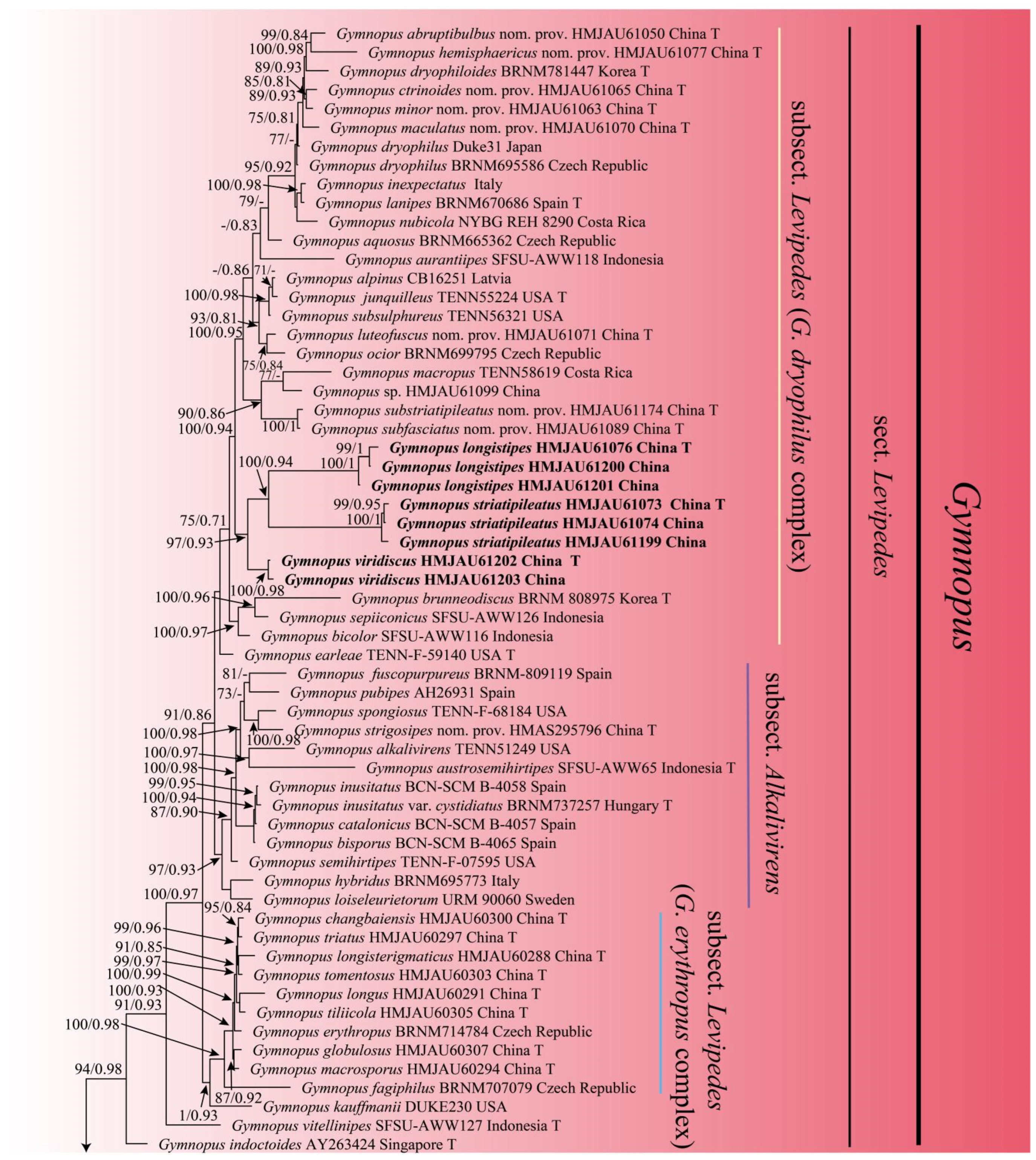
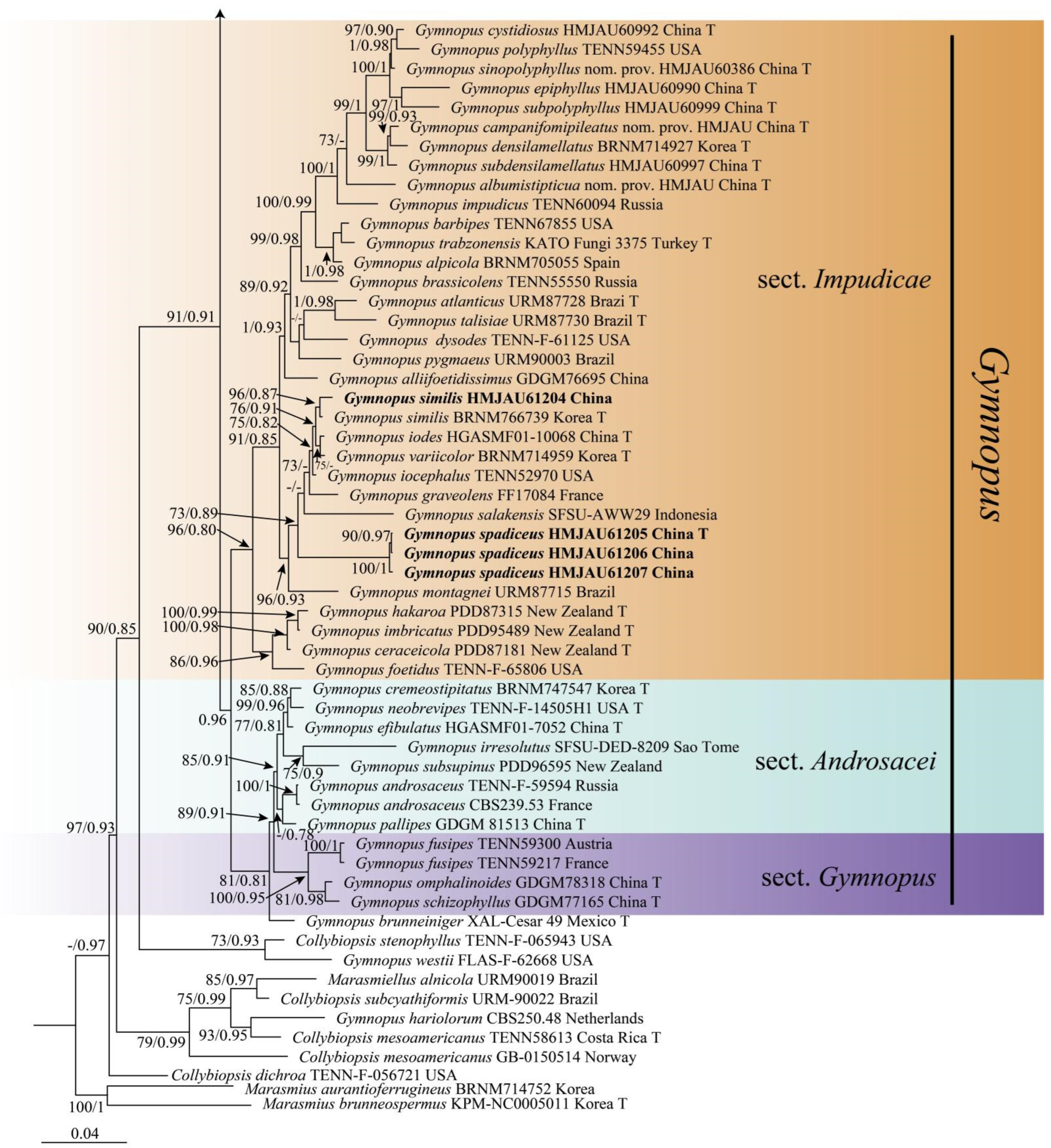
3.2. Taxonomy
3.2.1. New Species
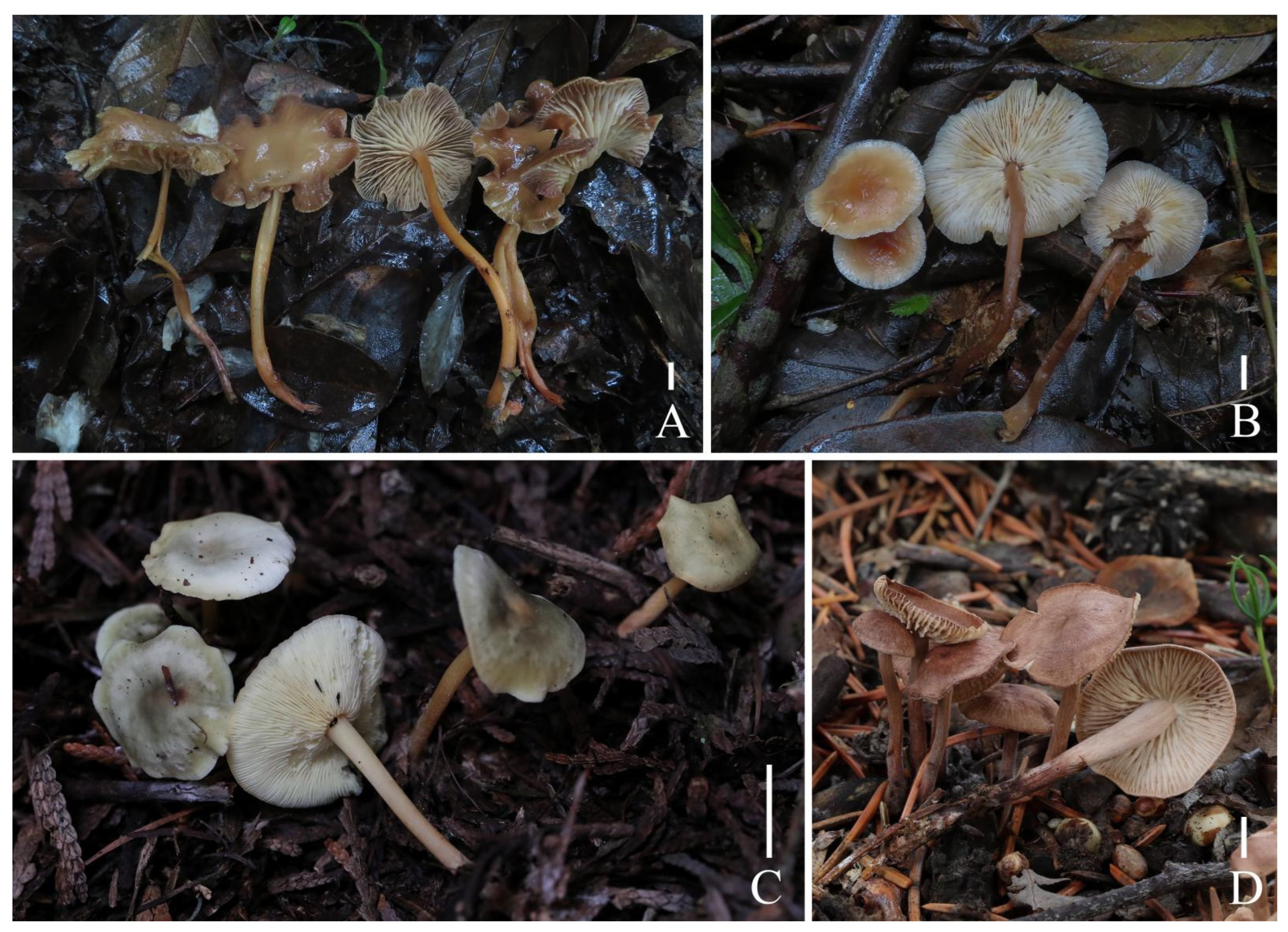

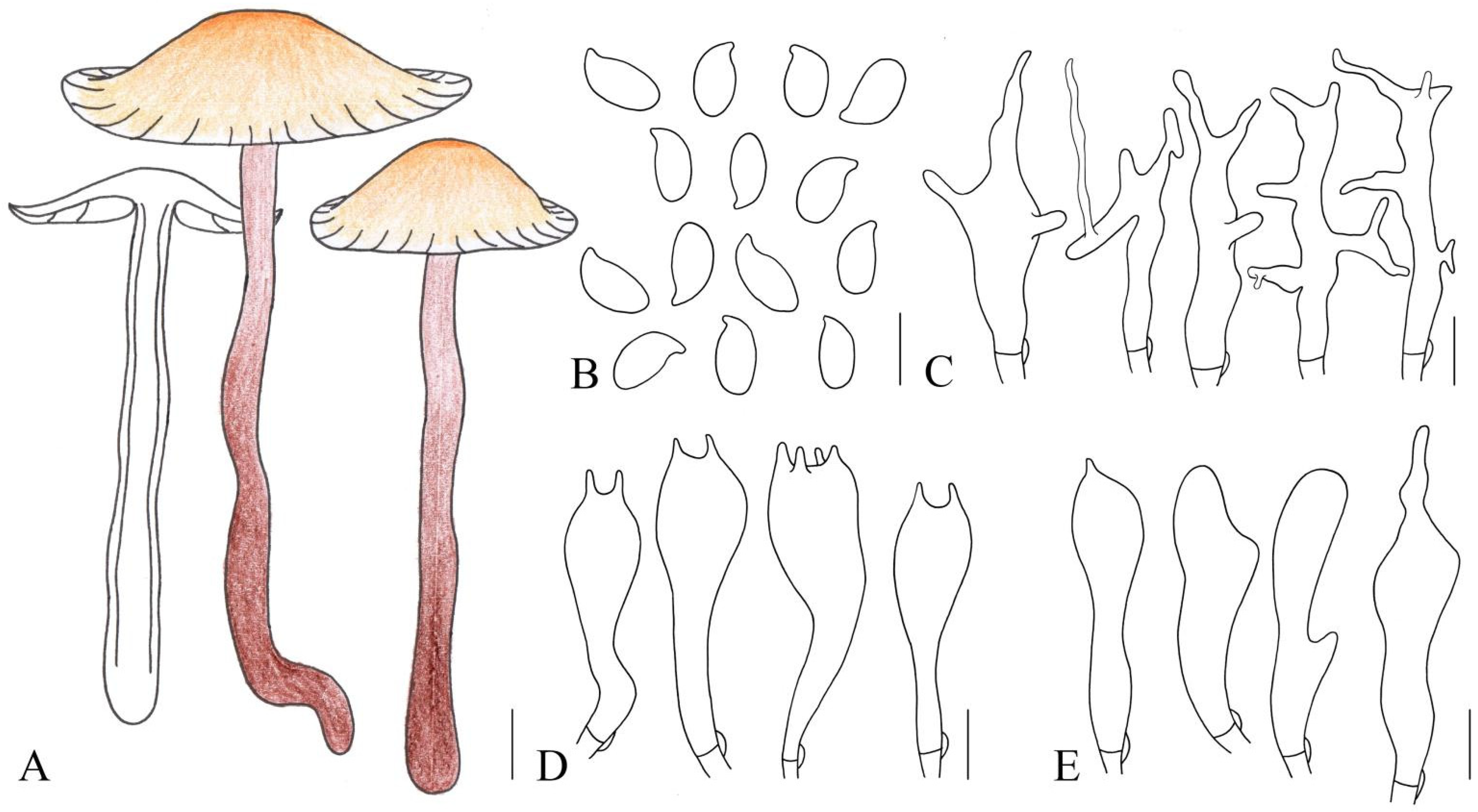
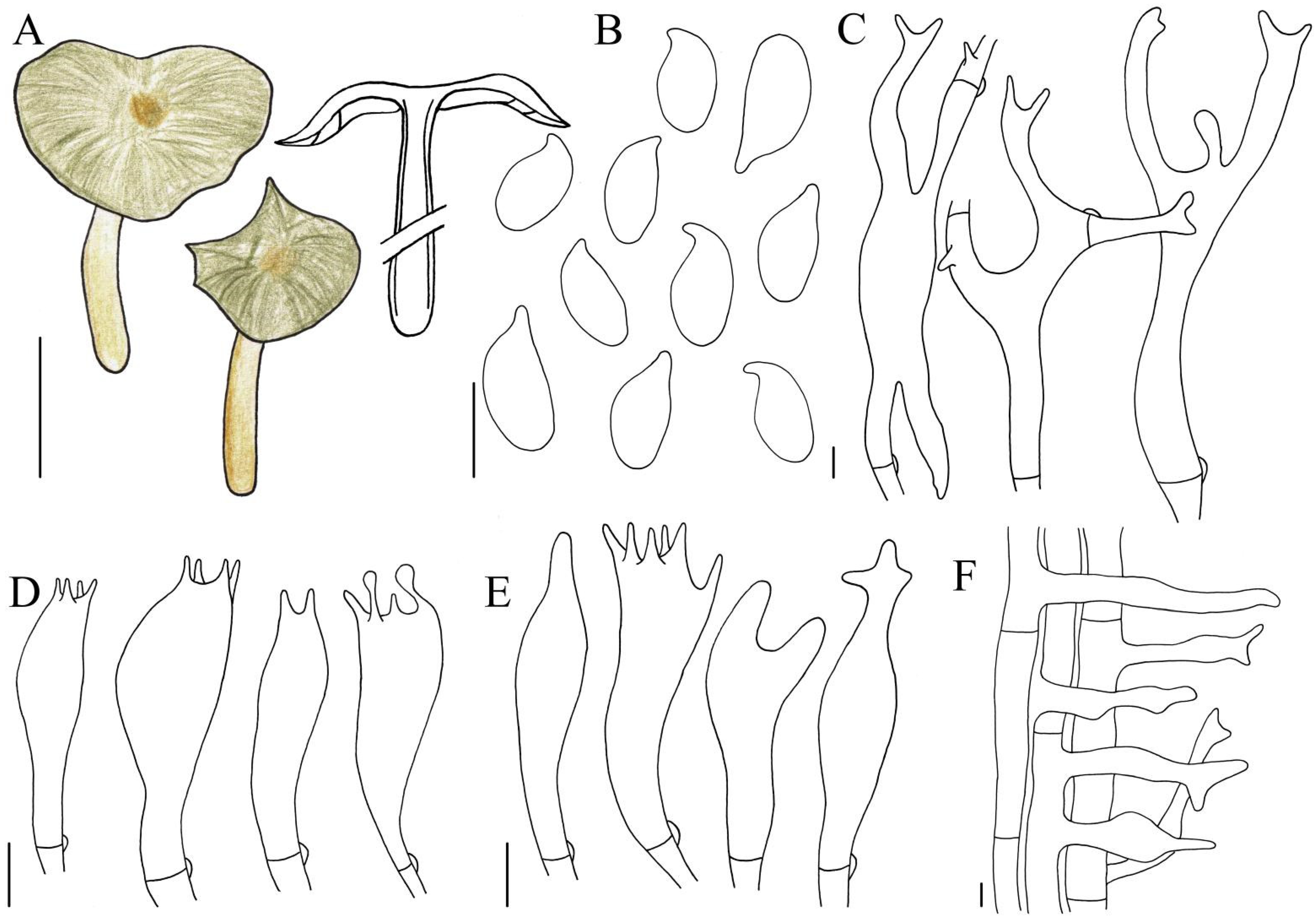

3.2.2. New Record of Jiangxi Province, China
- Gymnopus similis Antonín, Ryoo & Ka
- Key to the reported Gymnopus s.l. and related species from East China
| 1 Basidiospores amyloid | Rhodocollybia butyracea |
| 1 Basidiospores inamyloid | 2 |
| 2 Basidiomata with foetid smell | 3 |
| 2 Basidiomata without foetid smell | 6 |
| 3 Basidiomata white, small | Gymnopus alliifoetidissimus |
| 3 Basidiomata not white, small to medium | 4 |
| 4 Basidiomata marasmioid, covered with tomentose at stipe | Gymnopus similis |
| 4 Basidiomata gymnopoid, covered with pruinose at stipe | 5 |
| 5 Basidiomata small, arose from coniferous forest | Gymnopus spadiceus |
| 5 Basidiomata small to medium, arose on the ground of broad-leaved forest | Gymnopus dysodes |
| 6 Stipe smooth | 7 |
| 6 Stipe usually covered with tomentose or pruinose | 14 |
| 7 Basidiomata marasmioid | Gymnopus androsaceus |
| 7 Basidiomata not marasmioid | 8 |
| 8 Pileipellis green in KOH | Gymnopus fuscopurpureus |
| 8 Pileipellis not green in KOH | 9 |
| 9 Stipe red | 10 |
| 9 Stipe not red, usually happens in early spring or late autumn | 11 |
| 10 Pileus red, grows on ground | Gymnopus erythropus |
| 10 Pileus yellow to lemon yellow, grows on leaves | Gymnopus subsulphureus |
| 11 Cystidia absent | Gymnopus longistipes |
| 11 Cystidia present | 12 |
| 12 Caulocystidia present and massive | 13 |
| 12 Caulocystidia absent or rare | Gymnopus dryophilus |
| 13 Basidiomata marasmioid, stipe red | Gymnopus striatipileatus |
| 13 Basidiomata gymnopoid, stipe fresh to light greenish yellow | Gymnopus viridiscus |
| 14 Stipe fusiformis, pileipellis not Dryophila-structure | Gymnopus fusipes |
| 14 Stipe usually cylindrical, pileipellis usually Dryophila-structure | 15 |
| 15 Basidiomata small, marasmioid | 16 |
| 15 Basidiomata small to medium, usually gymnopoid | 17 |
| 16 Basidiomata small, grows on leaves | Gymnopus hirtellus |
| 16 Basidiomata, medium to large, grows on ground | Collybiopsisperonata |
| 17 Cystidia absent | 18 |
| 17 Cystidia present | 19 |
| 18 Hyphae blue in KOH | Gymnopus iocephalus |
| 18 Hyphae not blue in KOH | Gymnopus castaneus |
| 19 Stipe with white mycelioid at the base | 20 |
| 19 Stipe without white mycelioid at the base | 21 |
| 20 Caulocystidia absent | Collybiopsisbiformis |
| 20 Caulocystidia present | Collybiopsisconfluens |
| 21 Pileus covered with obvious stripe | Collybiopsispolygramma |
| 21 Pileus without obvious stripe | Collybiopsisluxurians |
4. Discussion
4.1. Morphological Characteristics in Genus and Species Delimitation
4.2. Phylogenetic Relationships within Gymnopus
Author Contributions
Funding
Institutional Review Board Statement
Informed Consent Statement
Data Availability Statement
Acknowledgments
Conflicts of Interest
References
- Mata, J.L.; Hughes, K.W.; Petersen, R.H. An investigation of/Omphalotaceae (Fungi: Euagarics) with emphasis on the genus Gymnopus. Sydowia 2006, 58, 191–289. [Google Scholar]
- Wu, F.; Zhou, L.W.; Yang, Z.L.; Bau, T.; Li, T.H.; Dai, Y.C. Resource diversity of Chinese macrofungi: Edible, medicinal and poisonous species. Fungal Divers. 2019, 98, 1–76. [Google Scholar] [CrossRef]
- Song, J.; Wang, X.; Huang, Y.; Qu, Y.; Zhang, G.; Wang, D. Analgesic effects of Marasmius androsaceus mycelia ethanol extract and possible mechanisms in mice. Braz. J. Med. Biol. Res. 2018, 51, e7124. [Google Scholar] [CrossRef] [PubMed]
- Persoon, C.H. Synopsis Methodica Fungorum 1; Apud Henricum Dieterich: Göttingen, Germany, 1801. [Google Scholar]
- Fries, E. Systema mycologicum: Sistens Fungorum Ordines, Genera et Species, Huc usque Cognitas; Ex Officina Berlingiana: Berling, Germany, 1821; Volume 1. [Google Scholar]
- Staude, F. Die Schwämme Mitteldeutschlands, Insbesondere des Herzogtums Coburg; Dietz: Coburg, Germany, 1857; Volume 1. [Google Scholar]
- Singer, R. The Agaricales in modern taxonomy. Lilloa 1949, 22, 1–832. [Google Scholar]
- Singer, R. The Agaricales in Modern Taxonomy, 2nd ed.; J. Cramer: Weinheim, Germany, 1962. [Google Scholar]
- Singer, R. The Agaricales in Modern Taxonomy, 3rd ed.; J. Cramer: Weinheim, Germany, 1975. [Google Scholar]
- Singer, R. The Agaricales in Modern taxonomy, 4th ed.; Koeltz Botanical Books: Koenigstein, Germany, 1986. [Google Scholar]
- Kühner, R.; Romagnesi, H. Flore Analytique des Champignons Supérieurs (Agarics, Bolets, Chanterelles): Comprenant les Espèces de l’Europe Occidentale et Centrale Ainsi que la Plupart de Celles de l’Algérie et du Maroc; Masson: Paris, Franch, 1953. [Google Scholar]
- Lennox, J. Collybioid genera in the Pacific Northwest. Mycotaxon 1979, 9, 117–231. [Google Scholar]
- Halling, R.E. The genus Collybia (Agaricales) in the northeastern United States and adjacent Canada. Mycologia 1983, 8, 1–148. [Google Scholar]
- Antonín, V.; Noordeloos, M.E. A monograph of Marasmius, Collybia and related genera in Europe. Part 1: Marasmius, Setulipes, and Marasmiellus. Libri. Botanici. 1993, 8, 1–229. [Google Scholar]
- Antonín, V.; Noordeloos, M.E. A monograph of Marasmius, Collybia and related genera in Europe. Part 2: Collybia, Gymnopus, Rhodocollybia, Crinipellis, Chaetocalathus, and additions to Marasmiellus. Libri. Botanici. 1997, 17, 1–256. [Google Scholar]
- Antonín, V.; Halling, R.; Noordeloos, M. Generic concepts within the groups of Marasmius and Collybia sensu lato. Mycotaxon 1997, 63, 359–368. [Google Scholar]
- Moncalvo, J.M.; Vilgalys, R.; Redhead, S.A.; Johnson, J.E.; James, T.Y.; Aime, M.C.; Hofstetter, V.; Verduin, S.J.; Larsson, E.; Baroni, T.J. One hundred and seventeen clades of euagarics. Mol. Phylogenet. Evol. 2002, 23, 357–400. [Google Scholar] [CrossRef]
- Mata, J.L.; Hughes, K.W.; Petersen, R.H. Phylogenetic placement of Marasmiellus juniperinus. Mycoscience 2004, 45, 214–221. [Google Scholar] [CrossRef]
- Wilson, A.; Desjardin, D. Phylogenetic relationships in the gymnopoid and marasmioid fungi (Basidiomycetes, euagarics clade). Mycologia 2005, 97, 667–679. [Google Scholar] [CrossRef] [PubMed]
- Noordeloos, M.E.; Antonín, V. Contribution to a monograph of marasmioid and collybioid fungi in Europe. Czech Mycol. 2008, 60, 21–27. [Google Scholar] [CrossRef]
- Oliveira, J.J.; Vargas-Isla, R.; Cabral, T.S.; Rodrigues, D.P.; Ishikawa, N.K. Progress on the phylogeny of the Omphalotaceae: Gymnopus s. str., Marasmiellus s. str., Paragymnopus gen. nov. and Pusillomyces gen. nov. Mycol. Prog. 2019, 18, 713–739. [Google Scholar] [CrossRef]
- Petersen, R.H.; Hughes, K.W. Collybiopsis and its type species, Co. ramealis. Mycotaxon 2021, 136, 263–349. [Google Scholar] [CrossRef]
- Hu, J.J.; Zhao, G.P.; Tuo, Y.L.; Rao, G.; Zhang, Z.H.; Qi, Z.X.; Yue, L.; Liu, Y.J.; Zhang, T.; Li, Y.; et al. Morphological and Molecular Evidence Reveal Eight New Species of Gymnopus from Northeast China. J. Fungi 2022, 8, 349. [Google Scholar] [CrossRef]
- Antonín, V.; Noordeloos, M.E. A Monograph of Marasmioid and Collybioid Fungi in Europe; IHW Verl: Eching, Germany, 2010. [Google Scholar]
- Teng, S.Q. Fungi of China; Science Press, Academic Sinica: Beijing, China, 1963; pp. 599–601. [Google Scholar]
- Liu, B.; Rong, F.X.; Jing, H.S.; Cao, J.Z. Three New Species of Holobasidiomycetes from China. J. Shanxi Univ. 1984, 4, 48–52. [Google Scholar]
- Mešić, A.; Tkalčec, Z.; Deng, C.Y.; Li, T.H.; Pleše, B.; Ćetković, H. Gymnopus fuscotramus (Agaricales), a new species from southern China. Phytotaxa 2011, 117, 321–330. [Google Scholar] [CrossRef]
- Deng, S.F.; Li, T.H.; Jiang, Z.D.; Song, B. Gymnopus ramulicola sp. nov., a pinkish species from southern China. Mycotaxon 2016, 131, 663–670. [Google Scholar] [CrossRef]
- Li, J.P.; Antonín, V.; Gates, G.; Jiang, L.; Li, T.H.; Li, Y.; Song, B.; Deng, C.Y. Emending Gymnopus sect. Gymnopus (Agaricales, Omphalotaceae) by including two new species from southern China. MycoKeys 2022, 87, 183–204. [Google Scholar] [CrossRef]
- Li, J.P.; Li, Y.; Li, T.H.; Antonin, V.; Hosen, M.I.; Song, B.; Xie, M.L.; Feng, Z. A preliminary report of Gymnopus sect. Impudicae (Omphalotaceae) from China. Phytotaxa 2021, 497, 263–276. [Google Scholar] [CrossRef]
- Li, J.P.; Pan, M.C.; Li, Y.; Deng, C.Y.; Wang, X.M.; Zhang, B.X.; Li, C.T.; Li, Y. Morpho-Molecular Evidence Reveals Four Novel Species of Gymnopus (Agaricales, Omphalotaceae) from China. J. Fungi 2022, 8, 398. [Google Scholar] [CrossRef]
- Li, J.P.; Song, B.; Feng, Z.; Wang, J.; Deng, C.Y.; Yang, Y.H. A new species of Gymnopus sect. Androsacei (Omphalotaceae, Agaricales) from China. Phytotaxa 2021, 521, 1–14. [Google Scholar] [CrossRef]
- Hu, J.J.; Song, L.R.; Tuo, Y.L.; Zhao, G.P.; Lei, Y.; Zhang, B.; Li, Y. Multiple evidences reveal new species and a new record of smelly Gymnopus (Agaricales, Omphalotaceae) from China. Front. Microbiol. 2022, 13, 968617. [Google Scholar] [CrossRef] [PubMed]
- Hu, J.J.; Zhao, G.P.; Tuo, Y.L.; Dai, D.; Guo, D.Z.; Rao, G.; Qi, Z.X.; Zhang, Z.H.; Li, Y.; Zhang, B. Morphology and molecular study of three new Cordycipitoid fungi and its related species collected from Jilin Province, northeast China. MycoKeys 2021, 83, 161–180. [Google Scholar] [CrossRef] [PubMed]
- Royal Botanic Garden, E. Flora of British Fungi: Colour Identification Chart; HM Stationery Office: Edinburgh, UK, 1969. [Google Scholar]
- César, E.; Bandala, V.M.; Montoya, L.; Ramos, A. A new Gymnopus species with rhizomorphs and its record as nesting material by birds (Tyrannideae) in the subtropical cloud forest from eastern Mexico. MycoKeys 2018, 42, 21–34. [Google Scholar] [CrossRef]
- Gardes, M.; Bruns, T.D. ITS primers with enhanced specificity for basidiomycetes-application to the identification of mycorrhizae and rusts. Mol. Ecol. 1993, 2, 113–118. [Google Scholar] [CrossRef]
- Vilgalys, R.; Hester, M. Rapid genetic identification and mapping of enzymatically amplified ribosomal DNA from several Cryptococcus species. J. Bacteriol. 1990, 172, 4238–4246. [Google Scholar] [CrossRef]
- Cubeta, M.; Echandi, E.; Abernethy, T.; Vilgalys, R. Characterization of anastomosis groups of binucleate Rhizoctonia species using restriction analysis of an amplified ribosomal RNA gene. Phytopathology 1991, 81, 1395–1400. [Google Scholar] [CrossRef]
- Morehouse, E.A.; James, T.Y.; Ganley, A.R.; Vilgalys, R.; Berger, L.; Murphy, P.J.; Longcore, J.E. Multilocus sequence typing suggests the chytrid pathogen of amphibians is a recently emerged clone. Mol. Ecol. 2003, 12, 395–403. [Google Scholar] [CrossRef]
- Coimbra, V.R.; Pinheiro, F.G.; Wartchow, F.; Gibertoni, T.B. Studies on Gymnopus sect. Impudicae (Omphalotaceae, Agaricales) from Northern Brazil: Two new species and notes on G. montagnei. Mycol. Prog. 2015, 14, 1–9. [Google Scholar] [CrossRef]
- Ryoo, R.; Antonín, V.; KA, K.H.; Tomšovský, M. Marasmioid and gymnopoid fungi of the Republic of Korea. 8. Gymnopus section Impudicae. Phytotaxa 2016, 286, 75–88. [Google Scholar] [CrossRef]
- Xu, J.; Yu, X.; Zhang, C.; Li, Y. Morphological characteristics and phylogenetic analyses revealed a new Calocybe (Lyophyllaceae, Basidiomycota) species from northeast China. Phytotaxa 2021, 490, 203–210. [Google Scholar] [CrossRef]
- Xu, J.; Yu, X.; Suwannarach, N.; Jiang, Y.; Zhao, W.; Li, Y. Additions to Lyophyllaceae sl from China. J. Fungi 2021, 7, 1101. [Google Scholar] [CrossRef]
- Petersen, R.H.; Hughes, K.W. Micromphale sect. Perforantia (Agaricales, Basidiomycetes); expansion and phylogenetic placement. MycoKeys 2016, 18, 1–122. [Google Scholar] [CrossRef]
- Thonpson, J. The CLUSTAL X windows interface: Flexible strategies for multiple sequence alignment aided by quality analysis tools. Nucleic Acids Res. 1997, 24, 4876–4882. [Google Scholar] [CrossRef]
- Katoh, K.; Standley, D.M. MAFFT multiple sequence alignment software version 7: Improvements in performance and usability. Mol. Biol. Evol. 2013, 30, 772–780. [Google Scholar] [CrossRef]
- Hall, T. BioEdit: A user-friendly biological sequence alignment editor and analysis program for Windows 95/98/NT. Nucleic Acids Symp. Ser. 1999, 41, 95–98. [Google Scholar]
- Zhang, D.; Gao, F.; Jakovlić, I.; Zou, H.; Zhang, J.; Li, W.X.; Wang, G.T. PhyloSuite: An integrated and scalable desktop platform for streamlined molecular sequence data management and evolutionary phylogenetics studies. Mol. Ecol. Resour. 2020, 20, 348–355. [Google Scholar] [CrossRef]
- Farris, J.S.; Kallersjo, M.; Kluge, A.G.; Bult, C. Testing significance of incongruence. Cladistics 1994, 10, 315–319. [Google Scholar]
- Swofford, D.L. PAUP*: Phylogenetic Analysis Using Parsimony (and Other Methods) 4.0 b10; Sinauer Associates: Sunderland, UK, 2002. [Google Scholar] [CrossRef]
- Kalyaanamoorthy, S.; Minh, B.Q.; Wong, T.K.; Von Haeseler, A.; Jermiin, L.S. ModelFinder: Fast model selection for accurate phylogenetic estimates. Nat. Methods 2017, 14, 587–589. [Google Scholar] [CrossRef] [PubMed]
- Ronquist, F.; Huelsenbeck, J.P. MrBayes 3: Bayesian phylogenetic inference under mixed models. Bioinformatics 2003, 19, 1572–1574. [Google Scholar] [CrossRef]
- Edler, D.; Klein, J.; Antonelli, A.; Silvestro, D. RaxmlGUI 2.0: A graphical interface and toolkit for phylogenetic analyses using RAxML. Methods Ecol. Evol. 2021, 12, 373–377. [Google Scholar] [CrossRef]
- Wilson, A.; Desjardin, D.; Horak, E. Agaricales of Indonesia: 5. The genus Gymnopus from Java and Bali. Sydowia 2004, 56, 137–210. [Google Scholar]
- Antonín, V.; Sedlák, P.; Tomšovský, M. Taxonomy and phylogeny of European Gymnopus subsection levipedes (Basidiomycota, Omphalotaceae). Persoonia 2013, 31, 179–187. [Google Scholar] [CrossRef]
- Hu, J.J. Taxonomic, Molecular Phylogenetic, and Biogeographic Evolution of Collybia s.l. in China. Ph.D. Thesis, Northeast Normal University, Changchun, China, 2024. [Google Scholar]
- Vilgalys, R.; Miller, O., Jr. Mating relationships within the Collybia dryophila group in Europe. Trans. Br. Mycol. Soc. 1987, 89, 295–300. [Google Scholar] [CrossRef]
- Vilgalys, R.; Miller, O., Jr. Morphological studies on the Collybia dryophila group in Europe. Trans. Br. Mycol. Soc. 1987, 88, 461–472. [Google Scholar] [CrossRef]
- Halling, R.E. Notes on Collybia V. Gymnopus section Levipedes in tropical South America, with comments on Collybia. Brittonia 1996, 48, 487–494. [Google Scholar] [CrossRef]
| Scientific Name | Voucher/Specimen Numbers | Country | GenBank Accession Numbers | ||
|---|---|---|---|---|---|
| ITS | nLSU | tef1-ɑ | |||
| Collybiopsis mesoamericanus (T) | TENN58613 | Costa Rica | DQ450035 | KY019632 | |
| C. stenophylla | TENN-F-065943 | USA | MN413331 | MW396886 | |
| C. subcyathiformis | URM-90022 | Brazil | KY404983 | KY404983 | |
| C. dichroa | TENN-F-056721 | USA | KY026654 | KY026654 | |
| Gymnopus abruptibulbus (T) | HMJAU61050 | China | OQ597084 | ||
| G. albumistipticus (T) | HMJAU61032 | China | OQ597081 | ||
| G. alkalivirens | TENN51249 | USA | DQ450000 | ||
| G. alliifoetidissimus | GDGM76695 | China | MT023344 | MT017526 | |
| G. alpicola | BRNM705055 | Spain | MK278102 | ||
| G. alpinus | CB16251 | Latvia | JX536168 | JX536191 | |
| G. androsaceus | TENN-F-59594 | Russia | KY026663 | KY026663 | |
| G. androsaceus | CBS239.53 | France | MH857174 | MH868713 | |
| G. aquosus | BRNM665362 | Czech Republic | JX536172 | JX536192 | |
| G. atlanticus (T) | URM87728 | Brazil | KT222654 | KY302698 | |
| G. aurantiipes | SFSU-AWW118 | Indonesia | AY263432 | AY639410 | |
| G. austrosemihirtipes (T) | SFSU-AWW65 | Indonesia | AY263422 | ||
| G. barbipes | TENN67855 | USA | KJ416269 | NG_059733 | |
| G. bicolor | SFSU-AWW116 | Indonesia | AY263423 | AY639411 | |
| G. bisporus | BCN-SCM-B-4065 | Spain | JN247551 | JN247555 | |
| G. brassicolens | TENN55550 | Russia | DQ449989 | ||
| G. brunneiniger (T) | XAL-Cesar 49 | Mexico | MT232389 | NG-075396 | |
| G. brunneodiscus (T) | BRNM808975 | Korea | MH589975 | MH589991 | |
| G. campanifomipileatus (T) | HMJAU61027 | China | OQ597064 | OQ594474 | |
| G. catalonicus | BCN-SCM-B-4057 | Spain | JN247552 | JN247556 | |
| G. ceraceicola (T) | PDD87181 | New Zealand | KC248405 | ||
| G. changbaiensis (T) | HMJAU60300 | China | OM030272 | OM033387 | |
| G. cremeostipitatus (T) | BRNM747547 | Korea | KF251071 | KF251091 | |
| G. ctrinoides (T) | HMJAU61069 | China | OQ597053 | OQ594463 | |
| G. cystidiosus (T) | HMJAU60992 | China | ON259024 | ON259036 | |
| G. densilamellatus (T) | BRNM714927 | Korea | KP336685 | KP336694 | |
| G. dryophiloides (T) | BRNM781447 | Korea | MH589967 | MH589985 | |
| G. dryophilus | BRNM695586 | Czech Republic | JX536143 | JX536196 | |
| G. dryophilus | Duke31 | Japan | DQ480099 | ||
| G. dysodes | TENN-F-61125 | USA | KY026666 | ||
| G. earleae (T) | TENN-F-59140 | USA | DQ449994 | KY019634 | |
| G. efibulatus | HGASMF01-7052 | China | OM970865 | OM970865 | |
| G. epiphyllus (T) | HMJAU60990 | China | ON259030 | ON259038 | |
| G.erythropus | BRNM714784 | Czech Republic | JX536136 | ||
| G. fagiphilus | BRNM707079 | Czech Republic | JX536129 | ||
| G. foetidus | TENN-F-65806 | USA | KY026682 | KY026682 | |
| G. fuscopurpureus | BRNM-809119 | Spain | MZ542559 | MZ542563 | |
| G. fuscotramus | GDGM26313 | China | JF303730 | ||
| G. fusipes | TENN59300 | Austria | AF505777 | ||
| G. fusipes | TENN59217 | France | AY256710 | AY256710 | |
| G. globulosus (T) | HMJAU60307 | China | OM030269 | OM033406 | |
| G. graveolens | FF17084 | France | MH422573 | MH422572 | |
| G. hakaroa (T) | PDD87315 | New Zealand | KC248410 | ||
| G. hariolorum | CBS250.48 | Netherlands | MH856329 | MH867883 | |
| G. hemisphaericus (T) | HMJAU61077 | China | OQ597057 | OQ594467 | |
| G. hybridus | BRNM695773 | Italy | JX536177 | ||
| G. imbricatus (T) | PDD95489 | New Zealand | KC248390 | ||
| G. impudicus | TENN60094 | Russia | KJ416263 | ||
| G.indoctoides (T) | AY263424 | Singapore | AY639419 | ||
| G. inexpectatus | Italy | EU622905 | EU622906 | ||
| G. inusitatus | BCN-SCM-B-4058 | Spain | JN247553 | JN247557 | |
| G. inusitatus var. cystidiatus (T) | BRNM737257 | Hungary | JN247550 | JN247554 | JX536179 |
| G. iocephalus | TENN52970 | USA | DQ449984 | KY019630 | |
| G. iodes (T) | HGASMF01-10068 | China | OM970869 | OM970869 | |
| G. irresolutus | SFSU-DED-8209 | Sao Tome | MF100973 | ||
| G. junquilleus (T) | TENN55224 | USA | NR_119582 | ||
| G. kauffmanii | DUKE230 | USA | DQ450001 | ||
| G. lanipes (T) | BRNM670686 | Spain | JX536137 | JX536205 | |
| G. loiseleurietorum | URM90060 | Sweden | KY321571 | KY321572 | |
| G. longisterigmaticus (T) | HMJAU60288 | China | OM030282 | OM033403 | |
| G. longistipes(T) | HMJAU61076 | China | PP646156 | PP646168 | PP654450 |
| G. longistipes | HMJAU61200 | China | PP646157 | PP646169 | PP654451 |
| G. longistipes | HMJAU61201 | China | PP646158 | PP646170 | PP654452 |
| G. longus (T) | HMJAU60291 | China | OM030285 | OM033400 | |
| G. luteofuscus (T) | HMJAU61071 | China | OQ597062 | OQ594472 | |
| G. macropus | TENN58619 | Costa Rica | DQ449979 | ||
| G. macrosporus (T) | HMJAU60294 | China | OM030266 | OM033397 | |
| G. maculatus (T) | HMJAU61070 | China | OQ597059 | OQ594469 | |
| G. minor (T) | HMJAU61064 | China | OQ597051 | OQ594461 | |
| G. montagnei | URM87715 | Brazil | KT222652 | ||
| G. neobrevipes (T) | TENN-F-14505H1 | USA | MH673477 | MH673477 | |
| G. nubicola | NYBG-REH-8290 | Costa Rica | AF505781 | ||
| G. obscuroides | GB-0150514 | Norway | KX958399 | KX958399 | |
| G. ocior | BRNM699795 | Czech Republic | JX536166 | JX536188 | |
| G. omphalinoides (T) | GDGM78318 | China | MW134044 | MW134730 | |
| G. pallipes (T) | GDGM81513 | China | MW582856 | OK087327 | |
| G. polyphyllus | TENN59455 | USA | AY256695 | ||
| G. pubipes | AH26931 | Spain | MZ542558 | MZ542562 | |
| G. pygmaeus | URM90003 | Brazil | KX869966 | KY088273 | |
| G. quercophilus | URM90061 | Sweden | KY404979 | ||
| G. salakensis | SFSU-AWW29 | Indonesia | AY263447 | ||
| G. schizophyllus (T) | GDGM77165 | China | MW134043 | MW134729 | |
| G. semihirtipes | TENN-F-07595 | USA | OK376741 | ||
| G. sepiiconicus | SFSU-AWW126 | Indonesia | AY263449 | ||
| G. similis (T) | BRNM766739 | Korea | KP336692 | KP336699 | |
| G. similis | HMJAU61204 | China | PP646167 | PP646179 | |
| G. sinopolyphyllus (T) | HMJAU60386 | China | OM970872 | OM970872 | |
| G. spadiceus(T) | HMJAU61205 | China | PP646160 | PP646172 | PP654454 |
| G. spadiceus | HMJAU61206 | China | PP646161 | PP646173 | PP654455 |
| G. spadiceus | HMJAU61207 | China | PP646162 | PP646174 | PP654456 |
| G. spongiosus | TENN-F-68184 | USA | KY026706 | KY026706 | |
| G. striatipileatus | HMJAU61199 | China | PP646164 | PP646176 | |
| G. striatipileatus | HMJAU61074 | China | PP646165 | PP646177 | |
| G. striatipileatus(T) | HMJAU61073 | China | PP646166 | PP646178 | |
| G. striatus | HMJAU60297 | China | OM030263 | OM033384 | |
| G. strigosipes (T) | HMAS295796 | China | OM970874 | OM970874 | |
| G. subdensilamellatus (T) | HMJAU60997 | China | ON259032 | ON259042 | |
| G. subfasciatus (T) | HMJAU61089 | China | OQ597067 | OQ594477 | |
| G. subpolyphyllus (T) | HMJAU60999 | China | ON259028 | ON259043 | |
| G. subsulphureus | TENN56321 | USA | DQ449972 | ||
| G. subsupinus | PDD96595 | New Zealand | KM975399 | KM975375 | |
| G. talisiae (T) | URM87730 | Brazil | KT222655 | KX958401 | |
| G. tiliicola (T) | HMJAU60305 | China | OM030275 | OM033393 | |
| G. tomentosus (T) | HMJAU60303 | China | OM030278 | OM033390 | |
| G. trabzonensis (T) | KATO Fungi 3375 | Turkey | KT271754 | ||
| G. variicolor (T) | BRNM714959 | Korea | LT594121 | KP348011 | |
| G. viridiscus(T) | HMJAU61202 | China | PP646159 | PP646171 | PP654453 |
| G. viridiscus | HMJAU61203 | China | PP646163 | PP646175 | PP654457 |
| G. vitellinipes (T) | SFSU-AWW127 | Indonesia | AY263429 | AY639432 | |
| G. westii | FLAS-F-62668 | USA | MK268238 | ||
| Marasmiellus alnicola | URM90019 | Brazil | KY302681 | KY302682 | |
| Marasmius aurantioferrugineus | BRNM714752 | Korea | FJ904962 | MK278334 | |
| M. brunneospermus (T) | KPM-NC0005011 | Korea | FJ904969 | FJ904951 | |
Disclaimer/Publisher’s Note: The statements, opinions and data contained in all publications are solely those of the individual author(s) and contributor(s) and not of MDPI and/or the editor(s). MDPI and/or the editor(s) disclaim responsibility for any injury to people or property resulting from any ideas, methods, instructions or products referred to in the content. |
© 2024 by the authors. Licensee MDPI, Basel, Switzerland. This article is an open access article distributed under the terms and conditions of the Creative Commons Attribution (CC BY) license (https://creativecommons.org/licenses/by/4.0/).
Share and Cite
Hu, J.-J.; Tuo, Y.-L.; Qi, Z.-X.; Li, X.-F.; Jiang, D.-H.; Zhang, B.; Li, Y. The Combination of Morphological and Phylogenetic Evidence Reveals Four New Gymnopus Species and New Distribution. J. Fungi 2024, 10, 672. https://doi.org/10.3390/jof10100672
Hu J-J, Tuo Y-L, Qi Z-X, Li X-F, Jiang D-H, Zhang B, Li Y. The Combination of Morphological and Phylogenetic Evidence Reveals Four New Gymnopus Species and New Distribution. Journal of Fungi. 2024; 10(10):672. https://doi.org/10.3390/jof10100672
Chicago/Turabian StyleHu, Jia-Jun, Yong-Lan Tuo, Zheng-Xiang Qi, Xue-Fei Li, Dong-Hua Jiang, Bo Zhang, and Yu Li. 2024. "The Combination of Morphological and Phylogenetic Evidence Reveals Four New Gymnopus Species and New Distribution" Journal of Fungi 10, no. 10: 672. https://doi.org/10.3390/jof10100672
APA StyleHu, J.-J., Tuo, Y.-L., Qi, Z.-X., Li, X.-F., Jiang, D.-H., Zhang, B., & Li, Y. (2024). The Combination of Morphological and Phylogenetic Evidence Reveals Four New Gymnopus Species and New Distribution. Journal of Fungi, 10(10), 672. https://doi.org/10.3390/jof10100672







